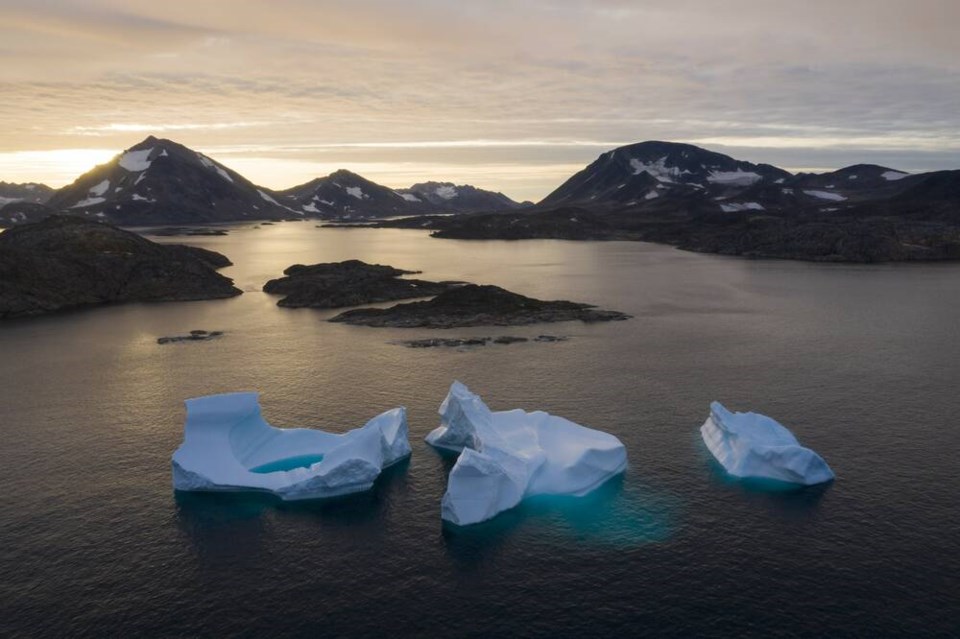Heat records are being broken — in some cases shattered by several degrees — around the world, including in England this summer, in northern India in March and April, and in British Columbia and the Pacific Northwest during June 2021.
“I was stunned by the three-dimensionality of the heat,” writes Dhruv Khullar, a New York doctor who was in Delhi in May. “The sun fried my skin but also somehow roasted me from within. I felt as if I’d swallowed a space heater.”
Last Sept. 16, Philip Steenkamp, president of Royal Roads University, who was born and raised in Botswana, remarked about B.C.’s heat dome.
“It was quite a terrifying experience for us,” he said at the start of the question-and-answer session following a climate change talk by Gwynne Dyer, the acclaimed author, historian and independent journalist. “I’ve never experienced heat like I did here.”
Keep in mind that these record heat events occurred with Earth having reached an average 1.1 C temperature increase over the pre-industrial level.
During his talk, Dyer said the 2015 Paris target of limiting warming to 1.5 C was never a realistic goal. He maintained that “the real never-exceed limit” is 2 C. But a month later, local climate scientist Andrew Weaver stated that an all-hands-on-deck approach is needed to limit warming to 3 C by 2100.
To hold warming to 2 C, we need to cut carbon emissions in half by 2030. But this is an exceedingly tall order given that we are currently going in the wrong direction.
National commitments as of last September will increase emissions by 16 per cent in 2030 compared to 2010. Not surprisingly, a recent UN International Panel on Climate Change report forecasts an end-of-century temperature increase of 2.4 to 3.5 C.
Noting that “averages lie,” Dyer generalized that a 2 C increase would equate to a 1 C increase over oceans, which cover 70 per cent of Earth’s surface, but a 3 C increase over land and a 4 C increase far in-land. Dyer added that calculations related to a 2 C increase depend on warming “remaining linear.”
We have virtually no control over non-linear warming, the most frequently cited example being abrupt increases of methane release from beneath the permafrost due to Arctic warming, which is occurring four times faster than the global average (and the Barents Sea is warming up to seven times faster). As a greenhouse gas, methane is many times stronger than carbon dioxide.
Based on the foregoing, you’d think there would be a strong consensus to achieve net-zero emissions by 2050. But that’s not yet the case, which prompts the question: How much wiser and better prepared are we today than 30 years ago?
In 1990, Václav Havel, as president of Czechoslovakia, told a special joint session of the U.S. Congress that humanity, especially its decision makers, “still don’t know how to put morality ahead of politics, science and economics.” The core of morality for Havel is responsibility, including a compassionate appreciation of the consequences of our actions.
Without a global revolution in human consciousness, “nothing will change for the better,” he said, adding that “the catastrophe toward which the world is headed … will be unavoidable.”
While society’s comprehension of the global warming threat has grown substantially in recent years, Dyer has little confidence that national governments will be able to reduce GHG emissions in a timely, effective manner.
He makes two key points. First, that if non-linear warming kicks in, a 6 C increase by the end of the century “is not inconceivable.”
With such an increase, many now habitable places would become uninhabitable, and humanity could lose 90 per cent of its present 7.9-billion population, producing a human transformation of quite a different sort, by entirely different means, imposed rather than of our choosing.
Second, as technology created the climate crisis, “we will mostly have to solve it with technology.” Dyer described geo-engineering, specifically Stratosphere Aerosol Injections (SAI) and Marine Cloud Brightening (MCB), to restrict temperature rise by reflecting sunlight.
Both SAI and MCB involve spraying aerosols into the atmosphere: tiny droplets of salt into clouds just above the surface of oceans in the case of MCB, and sulphur dioxide 20 kilometres up in the stratosphere in the case of SAI. Although he said, “a lot of people think this is actually evil,” he added it’s “probably going to be necessary.”
“Pay me now or pay me later,” a car maintenance TV commercial offered. The climate change pay-me-later scenario of geo-engineering is worthy of Dr. Strangelove but could easily come about if we don’t heed Havel’s warning about responsibility.
Meanwhile, what about the kids? Will they be all right? We have the extraordinary example of Greta Thunberg, who, as a 15- and 16-year-old, went from obscurity to become TIME’s Person of the Year in 17 months.
A stunning inspiration to some, she was and is a dunning nuisance to others. Now we have the Tyre Extinguishers. I don’t like their method, but I certainly understand their motivation.
“Will our students be equipped to face the suffering of the world without falling into despair?” asks Rabbi Dr. Ariel Burger, long-time colleague of Holocaust survivor, author, activist, and Nobel Prize winner Elie Wiesel.
“Will they find effective tools for growing their compassion and their courage, and for placing their courage in the service of compassion? Will they be empowered to act, rather than to submit to despair?”
Inspired by the urgent example of Greta Thunberg, Patrick Wolfe has been writing about climate change since January 2019. His book, A Snake on the Heart — History, Mystery, and Truth: The Entangled Journeys of a Biographer and His Nazi Subject, will be published by Iguana Books later this year.

